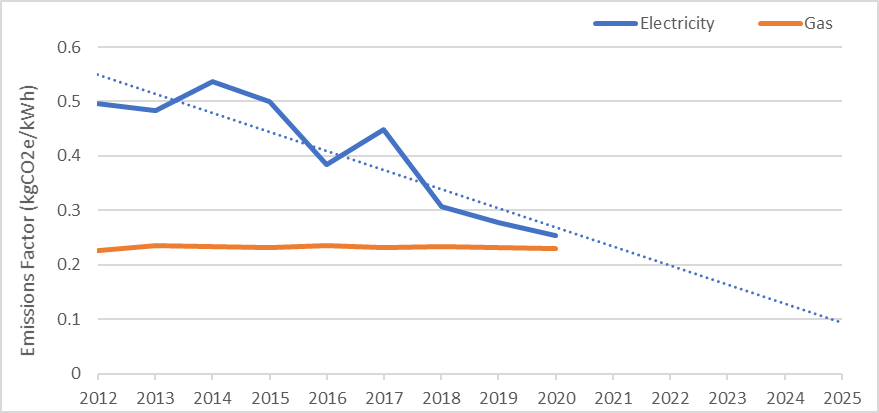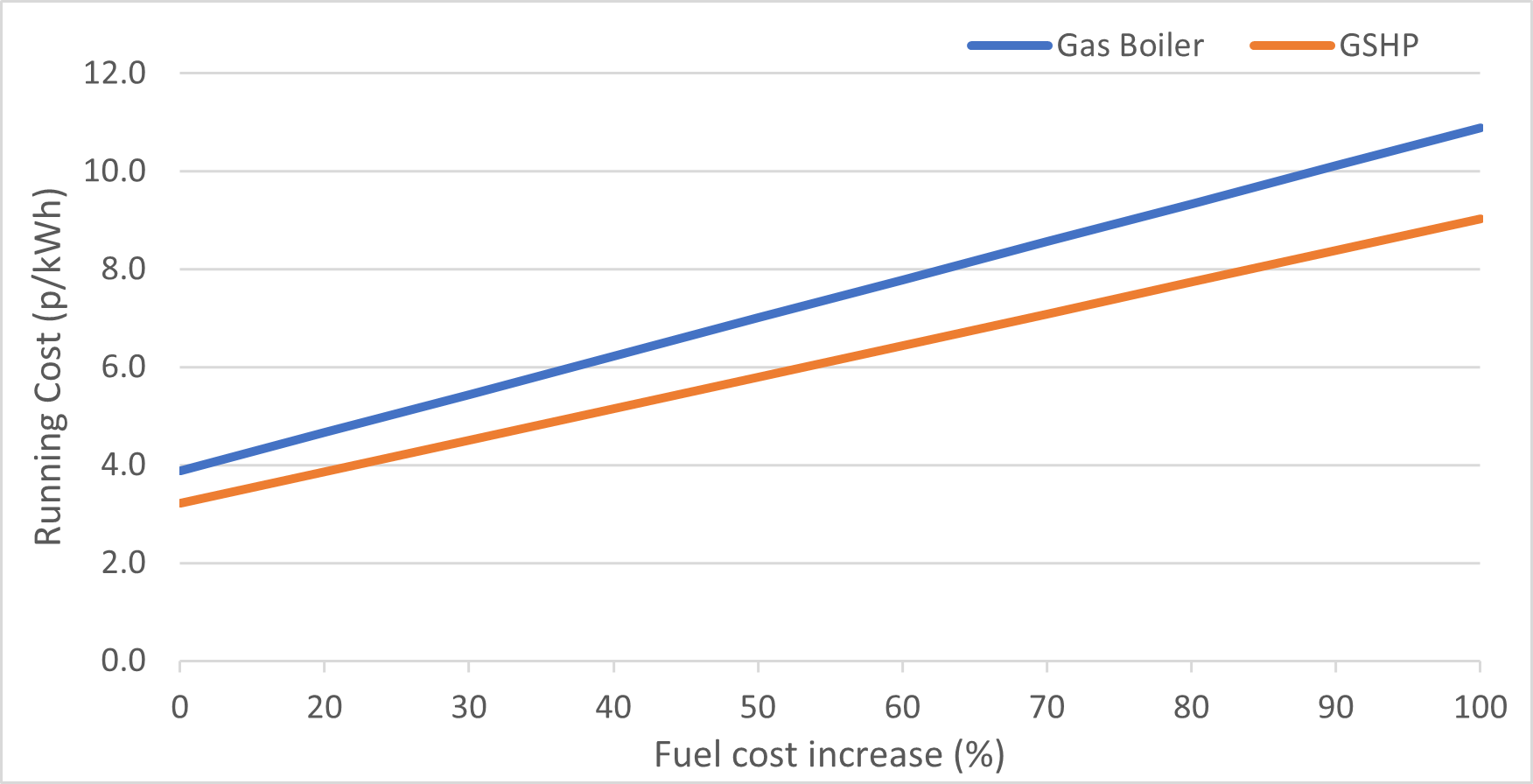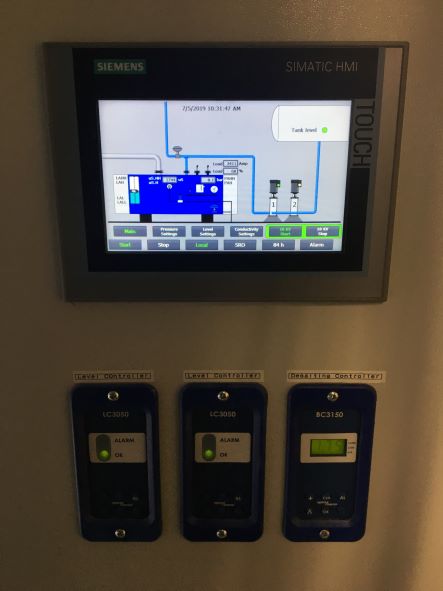Please click here to access the main AHDB website and other sectors.
- Home
- Knowledge library
- Electrification of Heat: Key market drivers and considerations
Electrification of Heat: Key market drivers and considerations
It is worth considering the key finance, emissions factors, energy market and legislative drivers associated with heat generated by electricity. Read on to find out more.
Comparing costs and Greenhouse Gas (GHG) emissions of electric heating systems
Fuel costs and the associated emissions factors need to be considered when choosing heating systems.
The fuel costs to deliver 100 kW of heat vary with the system used, as do the typical temperatures each system heat to and the GHG emissions produced. These factors will have to be weighed up alongside the practicalities of each system.
| Likely flow temperature (°C) | Fuel used to deliver 100kWh of heat (kWh) | Gas Cost | Electricity Cost | GHG Emissions (kg CO2e) | |
| Natural Gas Boiler | 85 | 111 | £3.89 | - | 25.58 |
| Ground Source Heat Pump | 45 | 22 | - | £3.22 | 5.63 |
| Air Source Heat Pump | 35 | 33 | - | £4.83 | 8.44 |
| Electric Boiler | 85 | 101 | - | £14.65 | 25.57 |
| Hybrid Gas & GSHP | 85 | 70 | £1.87 | £6.77 | 24.09 |
| Hybrid Gas & ASHP | 85 | 85 | £2.33 | £4.83 | 23.79 |
| Electric Direct Fired Air Heater | - | 100 | - | £14.59 | 25.49 |
While this is how the numbers currently stack up, changes in the energy market and renewables mix will affect the fuel cost and carbon emissions.
Greenhouse Gas (GHG) and Net Zero
Electricity storage and grid balancing alongside increasing renewable generation from sources such as Photo Voltaics(PV) and wind mean that electricity generation may well move to having zero emissions. Conversely, reducing emissions on the gas grid is more challenging, future biogas-to-grid incentive schemes, such as the GGSS (Green Gas Support Scheme), will increase the amount of biomethane in the natural gas grid. Also, developments in hydrogen fuel mixing may provide another low, or zero, carbon fuel into the mix. The difference between renewables mixing on the electricity and the natural gas grids is that biomethane still contains around 5% fossil fuel (in the form of propane), and there is a limit to the amount of hydrogen mixing that is possible.
Recent changes in emissions factors for the UK gas and electricity grids illustrate this point. If the reduction in emissions factors for UK electricity grids continues as it has in recent years, it could decrease below 0.1 kgCO2e/kWh by 2025. This would reduce the figures for electricity based GHG emissions by 60%. If the trend for natural gas continues, it would only decrease natural gas emissions by around 3%, although it is expected to be greater. Currently (2021) carbon emissions for a unit of energy (kWh) from either gas or electricity at point of use are now almost identical at around 180 – 190gCO2e/kWh.

The Energy Market
With the UK government goals of Net Zero carbon emissions by 2050, it is very likely that the non-commodity costs of natural gas will increase. Although electricity costs may also increase, the efficiency of electrical heating systems are much higher, meaning that an increase in electricity cost is felt less than an increase in combustion fuel cost as can be seen in this comparison of a gas boiler and Ground Source Heat Pump. Additionally, as the electricity grid renewables mix continues to increase, it will likely suffer less from a broadly implemented ‘energy carbon tax’ than natural gas will.

Running cost of a gas boiler and GSHP against a percentage increase in fuel cost
The main methods of renewable electricity generation in the UK (wind and solar) are inherently unreliable. With an increase in the renewables mix on the electricity grid, this unpredictability can lead to periods of very high and very low electricity prices. Having a large electricity load on site in the form of electrical heat generation can make the most of these periods to improve the economics of the system, particularly when coupled with a significant heat store. This gives the system the flexibility to maximise heat generation when prices are low and minimise generation during peak cost periods. However, to do this will require close attention to be paid to the relevant markets and more time invested into the management of the system than normal.
Grid Capacity
While there are benefits to using electricity for heating, an increase in the peak electricity demand would not be possible to satisfy with the current grid capacity. Significant load shifting, energy storage, and improvements to the grid infrastructure are necessary to support this kind of mass increase.
Depending on the location of your site and the available local capacity, there may be large costs associated with the grid connection required to satisfy your heating load with electricity – as well as any lighting, fans, and other electricity use on site.
Carbon Dioxide
Something to consider when switching from natural gas combustion to electrical heating is carbon dioxide enrichment. Using electricity for heat means no on-site generated CO2 for enrichment and therefore other sources need to be found.
A clear alternative for carbon dioxide enrichment is to use pure liquid CO2, which is purchased and vapourised on site as needed. Liquid carbon dioxide is more expensive than producing your own through natural gas combustion and is used most commonly on sites with RHI-accredited biomass combustion. However, it’s expected that the availability of liquid carbon dioxide will increase as more industries develop and implement carbon capture techniques. Additionally, the GGSS (Green Gas Support Scheme) could introduce a large source for carbon dioxide, driving down the price.
The Green Gas Support Scheme (GGSS)
GGSS is an incentive scheme for biomethane gas-to-grid installations, expected to open in Autumn 2021. Part of the upgrading process to make biogas fit for injection into the grid is removing carbon dioxide, which makes up between 20-50% of the gas. This means that for each MWh of biogas injected, between 45 – 180 kg of CO2 is produced.
Combusting natural gas to produce CO2 has a cost of around £189/tonne, whereas the typical cost of liquid pure CO2 is around £50/tonne. Gas combustion pulls ahead when considering the value of heat, however, if pure CO2 drops in price and natural gas increases in price that will change.
Useful links
Visit our GrowSave pages to read more about how you can save energy and improve efficiencies
Read more about the electrification of heat
Energy management – read some top tips for remembering the basics
Watch our webinar below: Taking steps towards net zero

Courtesy and copyright of Danstoker A/S.
Topics:
Sectors:
Tags:

